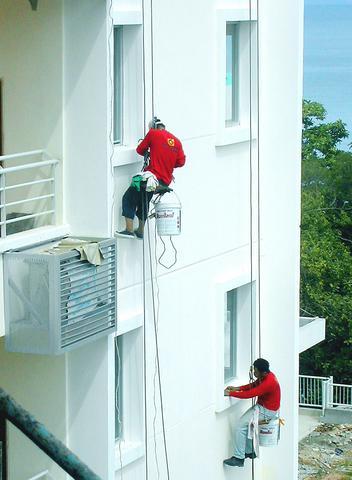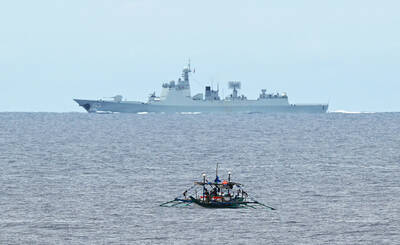With pristine beaches rivalling Asia's best holiday destinations, a five-star hotel, a reopened airport and a planned golf course, Cambodia's Sihanoukville is poised to jump into the global tourism arena.
Thousands of tourists are already lured to Cambodia by the ancient Angkor Wat temple complex but few other sights attract their attention or their desperately sought-after dollars.

PHOTO: AFP
Sniffing opportunity, the government and private investors are lining up to position the southwestern port town of Sihanoukville as a tropical getaway, competing with the likes of Thailand's Phuket and Indonesia's Bali.
"If we compare, the potential is better than Phuket because of the quality of sand -- it's white -- and the water is clean. The offshore islands have coral reefs, there's fishing," enthuses city tourism director Teng Huy.
A port town established in the 1950s -- it remains Cambodia's youngest city -- Sihanoukville became a popular resort among the elite until the rise of the Khmer Rouge, which embarked on a genocide that decimated the country.
It was re-discovered by backpackers in the 1990s and today retains a sleepy, faded charm, with the occasional cow wandering through the streets and ramshackle restaurants on many of its beaches.
The locally-owned Sokha Hotel has extended Sihanoukville's appeal beyond backpackers to well-heeled travellers by opening its 15-hectare, 180-room hotel in April, the first five-star operation here.
"The beach product is excellent, it's top class. Great sand, great sea, that's a great start, we're out of the gate and running well," says general manager Anthony O'Neill, a 12-year veteran of the Asian tourism industry.
More government help however is needed to rebuild the infrastructure shattered from conflict that only ended in 1998, as well as better attractions, to secure Sihanoukville's place on the international circuit, O'Neill says.
A nine-hole golf course being developed by Malaysia's Ariston Holdings along nearby Occheuteal beach is one such crucial drawcard, he says.
"The golf course concept has to be raced along ... because if you can't get core features you simply can't contain people in a holiday resort and even think you're going to challenge your competitors in Asia," he says.
"I'm competing with Bali, Phuket, even Pattaya. It's these markets we keep an eye on -- can we do it here?"
Sokha is just one of several hotels positioned to enter the market.
The quirky art deco Independence Hotel, which drew fashionable crowds in the 1960s prior to the 1975 rise of the Khmer Rouge, is due to open by September, while a 120-room hotel is packaged with the golf course project.
Scheduled flights -- also seen as vital to Sihanoukville's rejuvenation -- are on the horizon with the reopening of its airport in April to chartered flights. A runway extension is slated to be completed before year end, making it a potential destination for regional airlines.
Martin Standbury, the project manager for the golf course due to open within the coming year, says Sihanoukville may be sleepy for now, but its potential is enormous.
"For now tourists get a bit bored. There's the beach, cheap beer, seafood -- they probably need a few more attractions," he says.
"I reckon there is huge potential here over the next three to five years, not just for foreigners but the locals," he says, noting that Cambodia's emerging middle class has begun holidaying here again.
Business owners -- many of them foreigners who were travelling through but decided to stay, captivated by the landscape and laidback lifestyle -- say they have noticed a steady increase in numbers.
"Despite the anti-Thai riots (in Phnom Penh in January last year), SARS, (the terror attacks in) America and the elections, my trade has increased in the last year as has everybody else's," says hotel and bar owner Richard Blackley.
Teng Huy's office puts the number of tourists who visited last year at just over 114,000, 6 percent less than 2002 due to the regional SARS outbreak, but for the first three months this year the figure jumped by 29 percent from last year.
Blackley, who moved here four years ago, says the town was once awash with small arms -- like the rest of the country -- but has normalized and authorities are making an effort to renovate the town.
"Infrastructure is being repaired, government buildings are being repaired, you can see improvements with parks and gardens. ... And the race for land on the beaches is phenomenal," he says.
"I'm extremely optimistic. Every day something new is being done."
Li Li, a Chinese technical worker on a hydropower plant in a nearby province, comes here every few months with a half dozen colleagues who are drawn by the seafood and scenery.
"Sihanoukville is very, very beautiful -- the water, the sky," he said after a beachside seafood feast.
"I think more and more people will come to Cambodia and here."

Late last month Philippines Foreign Affairs Secretary Theresa Lazaro told the Philippine Senate that the nation has sufficient funds to evacuate the nearly 170,000 Filipino residents in Taiwan, 84 percent of whom are migrant workers, in the event of war. Agencies have been exploring evacuation scenarios since early this year, she said. She also observed that since the Philippines has only limited ships, the government is consulting security agencies for alternatives. Filipinos are a distant third in overall migrant worker population. Indonesia has over 248,000 workers, followed by roughly 240,000 Vietnamese. It should be noted that there are another 170,000

Hannah Liao (廖宸萱) recalls the harassment she experienced on dating apps, an experience that left her frightened and disgusted. “I’ve tried some voice-based dating apps,” the 30-year-old says. “Right away, some guys would say things like, ‘Wanna talk dirty?’ or ‘Wanna suck my d**k?’” she says. Liao’s story is not unique. Ministry of Health and Welfare statistics show a more than 50 percent rise in sexual assault cases related to online encounters over the past five years. In 2023 alone, women comprised 7,698 of the 9,413 reported victims. Faced with a dating landscape that can feel more predatory than promising, many in

“This is one of those rare bits of TikTok fitness advice with a lot of truth behind it,” says Bethan Crouse, performance nutritionist at Loughborough University. “Sometimes it’s taken a bit too literally, though! You see people chugging protein drinks as they’re scanning out of their gym.” Crouse recommends the athletes she works with consume 20-30g of protein within 30-60 minutes of finishing a resistance training session. “The act of exercising our muscles increases the breakdown of muscle proteins,” she says. “In order to restore, or hopefully improve them — and get gains such as increased muscle mass or strength —

“Far from being a rock or island … it turns out that the best metaphor to describe the human body is ‘sponge.’ We’re permeable,” write Rick Smith and Bruce Lourie in their book Slow Death By Rubber Duck: The Secret Danger of Everyday Things. While the permeability of our cells is key to being alive, it also means we absorb more potentially harmful substances than we realize. Studies have found a number of chemical residues in human breast milk, urine and water systems. Many of them are endocrine disruptors, which can interfere with the body’s natural hormones. “They can mimic, block